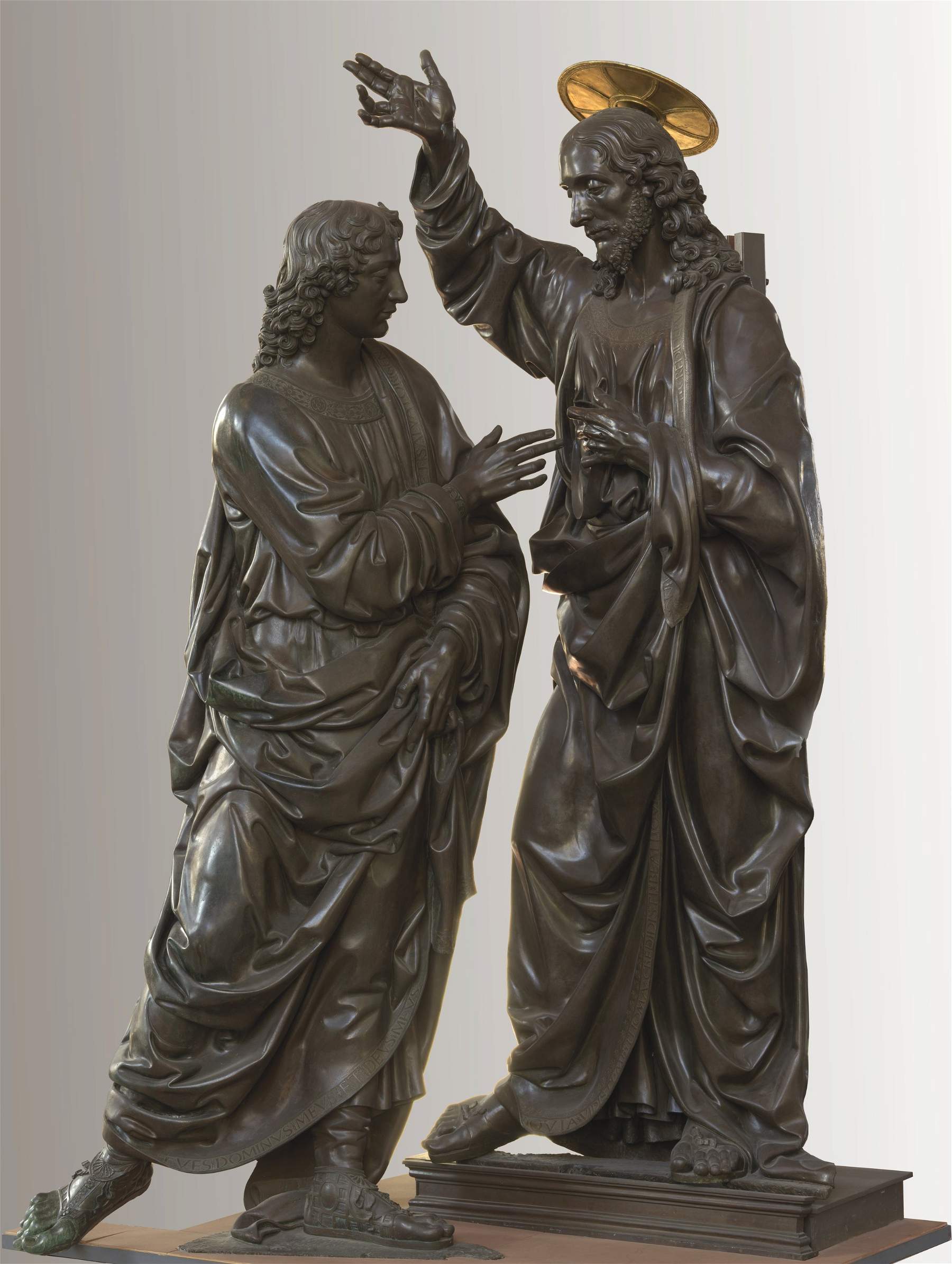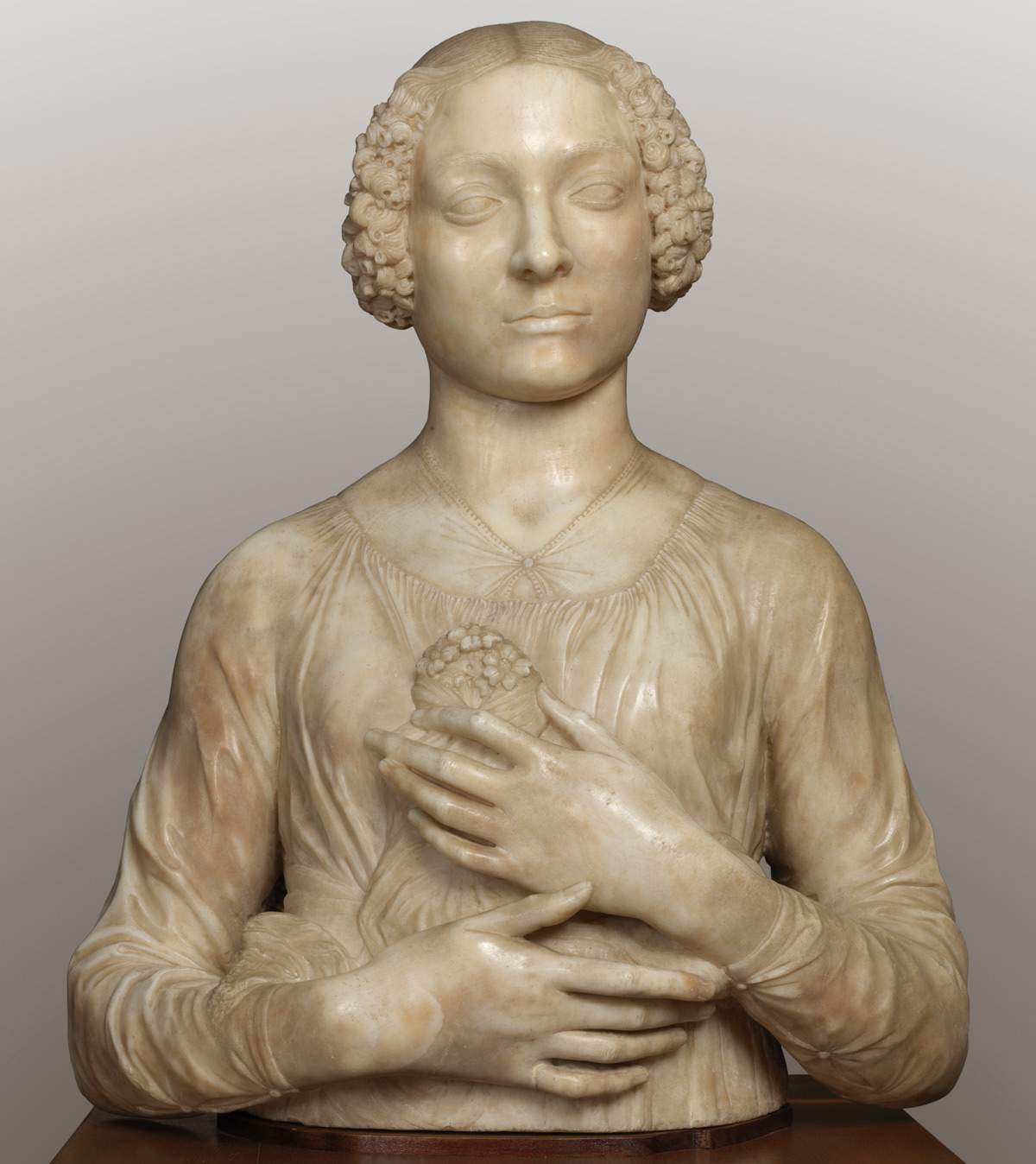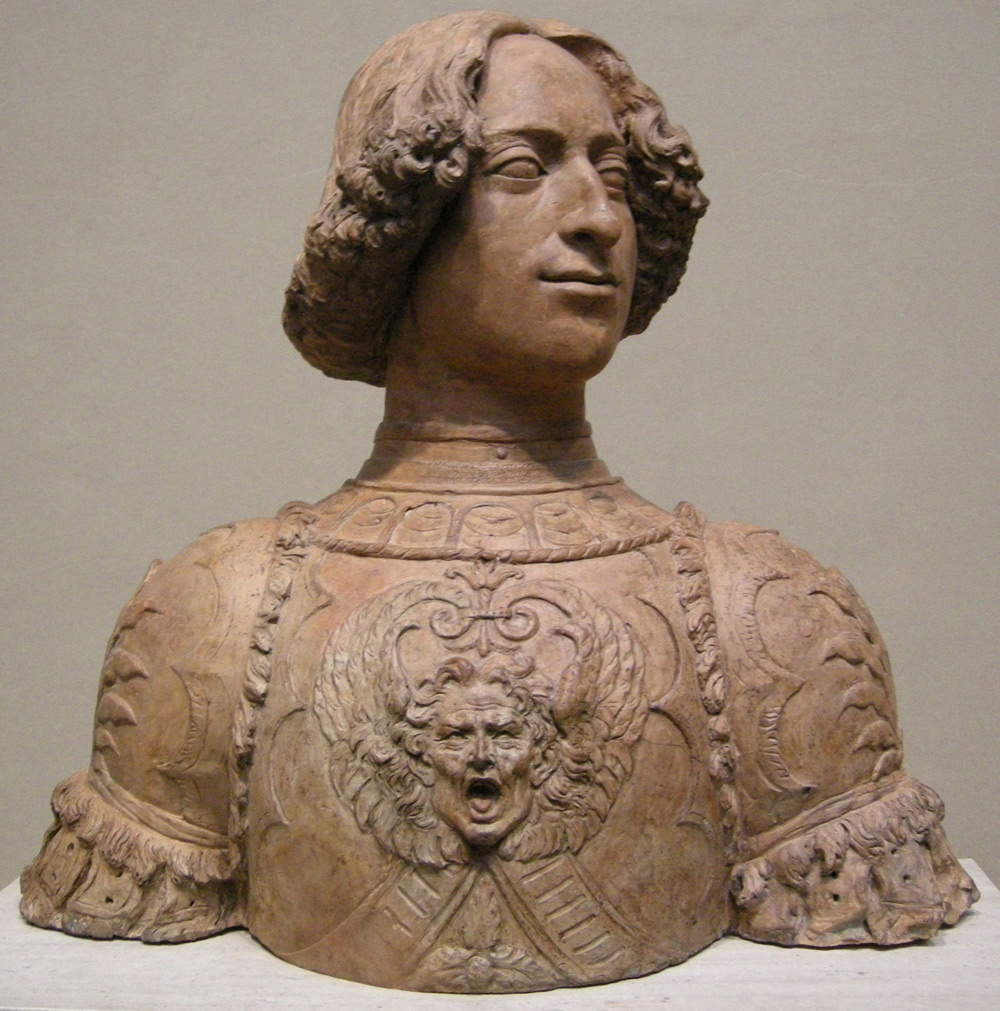Verrocchio (Andrea di Michele di Francesco Cioni; Florence, c. 1435-Venice, 1488) is one of the greatest sculptors of the Renaissance, but his was a multifaceted genius: he was also a goldsmith, a painter (although very few of his paintings are known to us), and he was the owner of the most advanced and innovative workshop in Florence of the second half of the 15th century, where some of the most important artists of the Renaissance itself were trained, such as Leonardo da Vinci, Sandro Botticelli, Lorenzo di Credi, and several others. Andrea di Michele di Francesco di Cione (this is his real name, which can sometimes be found simplified as “Andrea Cioni”) worked as a young man as an errand boy for one Francesco Verrocchio, and the nickname by which Andrea became is that of his employer, in keeping with a custom not uncommon at the time.
A highly innovative artist, in that he carried forward an art based on dynamism and naturalism reaching heights that no one else in Florence had touched, he gave birth to works whose results would be continued by other artists and in some cases continue to echo centuries later (a great 19th-century artist like Lorenzo Bartolini found Verrocchio a great source of inspiration). Moreover, in many cases Verrocchio (who also always had a keen eye forclassical art) also knew how to create delicate and refined works.
During the years of Lorenzo the Magnificent(read here an in-depth study dedicated to the works directly commissioned by the lord of Florence) Verrocchio was perhaps the artist who most determined the fortunes of the arts of the time. Verrocchio, have written scholars Andrea De Marchi and Francesco Caglioti, curators of the first monographic exhibition dedicated to the artist, “discovered his vocation for monumental sculpture by frequenting Desiderio da Settignano and the workshop of Donatello and opened himself year by year to ever new endeavors, established himself as the greatest bronze artist of his time, assiduously practiced drawing in various techniques, and finally landed in painting. In his early thirties, by about 1470 he was a point of reference for all, and his workshop a forge, like Donatello’s, open and generous, capable of bringing congenial arts into dialogue. He imposed a taste, from which descended the proto-classical turn of the last decades of the fifteenth century and, indirectly, the Modern Manner itself. Celebrated by his contemporaries, he was later accused (Vasari in the lead) of excess of study, as if the tension toward formal artifice was to the detriment of the truth of feelings, which he, on the other hand, intercepted and codified, even in the development of exemplary types: from bust portraits to heroic heads in the antique style, in profile, from figures in motion to a new image of Christ. His legacy was enormous and not fully acknowledged, for it bore wide-ranging fruit, including to Umbria and Rome, and, over time, thanks to his pupils’ students, Michelangelo and Raphael in primis.”
 |
| Verrocchio and Leonardo da Vinci, Baptism of Christ (c. 1475-1478; tempera and oil on panel, 177 x 151 cm; Florence, Uffizi) |
Andrea di Michele di Francesco di Cione, also known as Andrea di Cione or Andrea Cioni, was born in Florence around 1435 to Michele di Francesco, a fornaciaio (kiln worker) by profession, and Gemma. He takes the nickname by which he is universally known probably from one of his employers, Francesco di Luca Verrocchio, for whom he was an errand boy as a boy. The first document about him dates from 1452: young Andrea turns out to have been involved in a brawl but is declared innocent. In 1458 he claims to have been in the workshop of a goldsmith, but the name is not specified. We do not know who Verrocchio’s masters were: we do know, however, that as early as 1461 he was professing the craft of the artist, since that year Verrocchio submitted a project for the decoration of the chapel of the Madonna della Tavola in the cathedral of Orvieto, competing with other artists such as Desiderio da Settignano and Giuliano da Maiano, but the commission was not awarded to him. In 1467 he received the first payments for theIncredulity of St. Thomas made for the church of Orsanmichele on commission from the Tribunale della Mercanzia. However, the work would not be finished until 1483.
In 1468 Verrocchio painted a banner, now lost, for the Joust of Lorenzo the Magnificent, and the following year, again the Magnificent commissioned Andrea to paint the tomb of Giovanni and Piero de’ Medici. The work would be completed in 1472. Around 1470 he executed one of his earliest known works, the Resurrection of Christ(read more about the work here). In 1472, when he already owned his celebrated workshop, the large bronze ball cast by Verrocchio was placed on the lantern of the dome of Santa Maria del Fiore: it would fall in January 1600 struck by lightning, causing damage to the dome. It will later be restored at the behest of Grand Duke Ferdinand I, increased in size, and relocated in its place. In 1474 he was commissioned to paint the Madonna di Piazza, a painting preserved in Pistoia Cathedral that the artist had largely executed by his pupils. In contrast, the attestation of payment for the famous David currently in the Museo Nazionale del Bargello in Florence dates from 1476: it is one of the master’s greatest masterpieces. Around the same time he executed another of his most famous works, the Lady with a Small Bouquet. In the same period he was at work on the Baptism of Christ, perhaps his most famous painting: he executed it in collaboration with Leonardo da Vinci, finishing it perhaps in 1478 (according to the most recent hypotheses, however, the work was perhaps begun ten years earlier).
In 1479, the Venetian Republic commissioned Verrocchio to paint a monument to Bartolomeo Colleoni, a condottiere from Bergamo who had served for some time as captain general of the Venetian army. In 1486, Andrea del Verrocchio moved to Venice to begin bronze casting of the monument to Bartolomeo Colleoni. The artist died in Venice in 1488: his remains were brought to Florence where he was buried in the church of Sant’Ambrogio (today only a plaque commemorates him).
 |
| Andrea del Verrocchio, Incredulity of St. Thomas (1467-1483; bronze with gilding, 241 x 140 x 105 cm; Florence, Church and Museum of Orsanmichele, from the tabernacle of the Università della Mercanzia) |
 |
| Andrea del Verrocchio, Victorious David (c. 1468-1470; bronze with traces of gilding, 122 x 60 x 58 cm; Florence, Museo Nazionale del Bargello, inv. Bronzi 450 - Goliath’s head and inv. Bronzi 451 - David) |
 |
| Andrea del Verrocchio and Lorenzo di Credi, Madonna and Child between St. John the Baptist and St. Donatus of Arezzo known as Madonna di Piazza (c. 1475-1486; oil on panel, 196 x 196 cm; Pistoia, Cathedral of San Zeno) |
A journey to discover Verrocchio’s art can begin with theIncredulity of St. Thomas, a work he was commissioned to paint for one of the exterior niches of the church of Orsanmichele, where artists such as Donatello, Lorenzo Ghiberti, Nanni di Banco and others had already worked. Each of Florence’s arts (the professional guilds ) had a niche with a statue of its patron saint: the one for which Verrocchio’s statue was destined belonged to the Tribunale della Mercanzia, the body designed to settle disputes between the arts, and the niche is the most prominent because it faces Via dei Calzaioli, the main street in the center of Florence (the original is now in the Orsanmichele Museum; the niche houses a reproduction instead). Verrocchio’s bronze group sanctions a clear break with tradition: it is, in fact, a profoundly different work from those that had previously been made for Orsanmichele. First of all, because the artist does not limit himself, like his colleagues who had preceded him, to making only the statue of the patron saint, that is, St. Thomas, but he places the figure of Christ alongside him to recreate the very famous episode of unbelief, and none of the artists who had preceded him had gone so far as to imagine such a solution. It is then a work marked by the marked dynamism that constitutes the most innovative trait of Verrocchio’s art: in this Incredulity we see in fact an action, a real scene in movement, with St. Thomas entering from the left, examining the body of Jesus, who in turn removes his robe and raises his arm to facilitate the operation of his disciple. A group in which, then, everything is movement. Even in the disposition of the characters: St. Thomas, in fact, protrudes from his niche, seeming almost to be arriving from the outside, and again no one before Verrocchio had performed a similar operation in Orsanmichele (the artist therefore opts for a completely original solution). It is therefore a real scene, embodying one of the ideals of the Florentine Renaissance, the humanization of sacred figures.
Other sculptures communicate this sense of movement and naturalism: among them, the Putto col delfino in Palazzo Vecchio, made for the Medici (originally a fountain executed for the Medici Villa at Careggi), and probably studied from life, given the veracity of its features. And the same is true of what are probably Verrocchio’s two most famous sculptures: the David (commissioned by the Medici, made before 1476, perhaps for Lorenzo the Magnificent) and the Lady of the Bouquet. The David sketches a triumphant smile, has a proud and confident gaze, and its modernity is to be found first and foremost in its expression and pose, from which its author’s taste for naturalism is evident. Intense expressiveness also characterizes the Dama del mazzolino, an important work that introduces relevant novelties, the greatest of which is the cut Verrocchio decides to give the figure, that is, from the navel up, something no one had done before him. This view gives the sculptor the opportunity to also depict the subject’s arms and hands, thus increasing her expressiveness, as we see the young woman clutching the bouquet of flowers almost covering herself in a sign of shyness and shyness. Another novelty is the slight inclination of the head, which gives greater naturalism to the work, in keeping with Verrocchio’s research.
Verrocchio also renewed the genre of the funerary monument, with the tomb of Piero and Giovanni de’ Medici, commissioned by Lorenzo the Magnificent in 1469 (Piero and Giovanni were respectively the Magnificent’s father and uncle), and finished in 1472: it is located in the basilica of San Lorenzo in Florence and is a sarcophagus richly decorated with natural motifs and resting on lion paws. It is one of the first cases in sculpture of the time in which the use of different materials (porphyry for the sarcophagus, bronze for the decorations, and marble for the base) is noted, which also demonstrates Verrocchio’s ability to make good use of such different materials while also managing to combine them harmoniously. Another new element is given by the placement of the tomb inside the church, that is, inside a dividing wall, so that the work could be admired on two sides, when in contrast the tombs previously made in Florence were set against the walls. Finally, Verrocchio’s portrait-busts deserve a mention, such as that of Giuliano de’ Medici, the brother of the Magnifico who was assassinated in 1478 during the Pazzi conspiracy (read more about the conspiracy here), and it is a celebratory portrait executed between 1475 and 1478 that shows a smiling Giuliano dressed in classical armor, an expression that expresses at the same time pride but also serenity, and above all with his head turned as per the typical style of Verrocchio who did not like to make rigidly frontal busts but preferred precisely to rotate the heads of the subjects portrayed precisely to offer the viewer different points of view. Even in portraits Verrocchio innovated by infusing his naturalism to create more intense and expressive works.
 |
| Andrea del Verrocchio, Dama dal mazzolino (c. 1475; marble, 59 x 46 x 24 cm; Florence, Museo Nazionale del Bargello, inv. Sculpture 115) |
 |
| Andrea del Verrocchio, Spiritello con pesce o Putto col delfino (c. 1470-1475; bronze, 70.3 x 50.5 x 35 cm; Florence, Musei Civici Fiorentini-Museo di Palazzo Vecchio, inv. MCF-PV 2004-10615). Restoration of the work was made possible thanks to the generous contribution of Friends of Florence |
 |
| Andrea del Verrocchio, Giuliano di Piero de’ Medici (c. 1475; terracotta, formerly painted, 61 x 66 x 28.3 cm; Washington, National Gallery of Art, Andrew W. Mellon Collection, 1937.1.127) |
Verrocchio’s workshop was among the most important of the Renaissance, and certainly the largest in second-century Florence. We should not, however, imagine it as a school in the modern sense of the term: the organization of a workshop in Renaissance Florence was very different from how we might imagine a school or academy nowadays, since in a workshop of the time only the craft was learned (that is, there were no theoretical teachings: it would not come to combining theory with practice until the late sixteenth century). Pupils became painters, sculptors, goldsmiths, and so on: one entered the workshop at a very young age, as a child, and learned exclusively practical knowledge, starting with drawing.
Perhaps the fact that Verrocchio had such good fortune as a master and from his workshop came many pupils destined to become greats in the history of art may be due not only to his undoubted teaching skills, but also to the considerable space Verrocchio himself gave his pupils. It is difficult to attribute pictorial works to Verrocchio with certainty precisely because his pupils took an active part in the work he was commissioned to do: Verrocchio conceived the compositions and sketched out the drawings, but it was often his pupils who translated the ideas into painting. For example, in the case of the Madonna di Piazza, a masterpiece that is in Pistoia Cathedral and was commissioned from Verrocchio in 1474 (it is probably the most documented Verrocchio painting), the master conceived the composition but it was mainly his students who painted the work. The major role fell to Lorenzo di Credi, who moreover was one of the youngest of his pupils. The importance of Verrocchio’s workshop is determined not so much by what was learned here as by the quality of the master, his way of teaching his pupils, and the generosity with which the master allowed the most deserving pupils, from a very young age, to participate in important commissions.
To get a complete overview of Verrocchio’s art, it is necessary to travel to Florence and tour its main museums. The early masterpiece, theIncredulity of St. Thomas, can be found at the Orsanmichele Museum, at the Museo di Palazzo Vecchio you can instead admire the Putto con delfino, and then again at the Museo del Bargello you can see the David, the Lady with a Small Bouquet, the Resurrection of Christ and a large wooden crucifix, at the Museo dell’Opera del Duomo you can see the Beheading of the Baptist, and finally you end at the Uffizi where the Baptism of Christ, created together with Leonardo da Vinci, is on display. In Italy, few other cities preserve his works: the best known and most important outside Florence, however, is surely the equestrian monument to Bartolomeo Colleoni, located in Campo Giovanni e Paolo in Venice.
Works by Verrocchio can also be found in some foreign museums: among the most important are the portrait of Giuliano de’ Medici at the National Gallery in Washington, the Young Gentlewoman at the Frick Collection in New York, the model for the cenotaph of Cardinal Niccolò Forteguerri at the Victoria and Albert Museum in London, and the two angels from the same cenotaph preserved at the Louvre (one of which, moreover, is attributed by some to Leonardo da Vinci).
 |
| Andrea del Verrocchio: life and works of Leonardo da Vinci's master |
Warning: the translation into English of the original Italian article was created using automatic tools. We undertake to review all articles, but we do not guarantee the total absence of inaccuracies in the translation due to the program. You can find the original by clicking on the ITA button. If you find any mistake,please contact us.